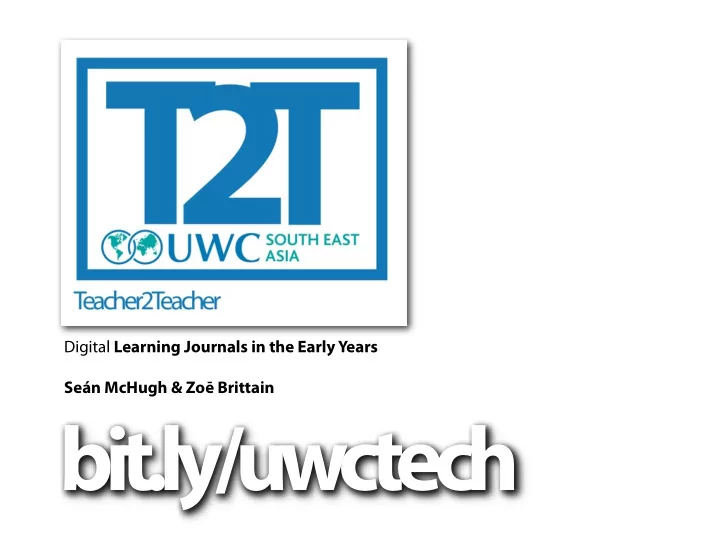

Digital Learning Journals in the Early Years Seán McHugh & Zo ē Brittain bit.ly/uwctech
Seán McHugh | Transformational Technology bit.ly/ SAMMS smc@uwcsea.edu.sg | @proteanteacher | bit.ly/pr0tean
Ruben Puentedura (2008). SAMR model for enhancing technology integration. SAMR
R A T Replacement Tech serves merely as a di ff erent means to the same instructional end Amplification Tech increases e ffi ciency and productivity without fundamental change Transformation Tech allows forms of instruction and learning that were previously inconceivable Hughes J, Thomas R & Scharber C (2006). Assessing Technology Integration: The RAT – Replacement, Ampli fj cation, and Transformation - Framework.
Replacement Tech serves merely as a di ff erent means to the same instructional end Amplification Tech increases e ffi ciency and productivity without fundamental change Transformation Tech allows forms of instruction and learning that were previously inconceivable
Replacement Tech serves merely as a di ff erent means to the same instructional end Amplification Tech increases e ffi ciency and productivity without fundamental change Transformation Tech allows forms of instruction and learning that were previously inconceivable
Replacement Tech serves merely as a di ff erent means to the same instructional end Amplification Tech increases e ffi ciency and productivity without fundamental change Transformation Tech allows forms of instruction and learning that were previously inconceivable
How can we make Learning Journals ational ?
practice Everywhere at once Start in one place, seamlessly continue in another, or even while you move between one and the other, and another, and another... The boundaries between school and life and work become permeable . Instead of stop/start we pause/play. Learners make connections between experiences even if the borders between domains seem to be highly delineated, such as home and school, fj eld trips. Less marking , more monitoring, guiding, clarifying, redirecting, a ffj rming, correcting... Feedback and feed forward and times and in places and spaces that suit the teaching and learning.
Unprecedented access to expertise World-renowned expertise, a symphony of voices and opinions, and peer-to- peer learning opportunities are all a click away. With great access comes great accountability , now the opinions of many shine the light of criticism, correction and congratulation on words and ideas that would otherwise have remained in obscurity. Digital technologies provide an unprecedented level of global access to information that is unique in history —entire societies, regardless of class, culture, or creed, have access, not just a social or academic elite.
Multiple modes magnify meaning All human communication is intrinsically multimodal . ICTs free us from the constraints of traditional media, free to communicate in ways that are more natural, more authentic. Writing is now no longer the central mode of representation in learning. Still/moving images are increasingly prominent as ‘ makers of meaning ’ (Kress, 2005). The principal modes are: written or spoken language, intonation, imagery, gesture, facial movements, and action.
Mending, mashing , and making Screen content is multimodal, dynamic, fm uid, mutable , provisional. The 'undo' tool is one of the most transformational ways of working ever conceived, unlike the page, the screen forgives . This ability to replicate/rewind/review/redo is like a virtual time machine—you know that you can always undo , which leads to an unprecedented sense of con fj dence—con fj dence to play and experiment.
Learning that is social & networked Web 2.0 tools empower ‘social learning’ , through global and local creative collaboration . Social synchronicity & asynchronicity means that students and teachers can make more e fg ective use of time to re fm ect and respond to feedback than in a traditional classroom. Social learning allows students to become learning resources for one another at times and in places and spaces that are most suitable to them . Social learning creates a context of reciprocity that frees teachers to focus on dynamic monitoring and frequent feedback instead of marking.
• Situated (work anywhere) • Access (influence, information, expertise) • Multi-modal (screen centred, ‘rich’ content) • Mutable (provisional, liquid, flexible, dynamic) • Socially networked (people power)
Situated Access that is Multi-Modal, Mutable & Socially Networked SAMMS
portfolio or learning
Brian, K2ZBr
bit.ly/ uwckindy smc@uwcsea.edu.sg @proteanteacher bit.ly/pr0tean Seán McHugh
Recommend
More recommend